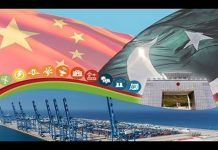Since 2013 when the idea of a China-Pakistan Economic Corridor (CPEC) was first conceived till date, naysayers have directed quite a bit of criticism at this mammoth set of landmark projects. By the time Beijing hosted the ‘Belt and Road Forum’ much of that criticism began to implode, leaving behind a trail of far-fetched fears.
Calling CPEC a ‘debt-trap’, the detractors continued to inject toxic trepidations into people’s minds. These adverse views — which are lapped up by our antagonistic neighbour — threaten to disrupt Pakistan’s economic leapfrog. In this piece I will endeavour to assess some of the broader contours of CPEC’s cost-benefit analysis without referring to the economic and financial jargon and make it understandable to the masses and cast off any misgivings about CPEC.
To begin with, the critics must admit, the internationally well-established economic truism, that an underdeveloped and middle-income country must attract foreign direct investment (FDI) to strengthen its ability of producing both exportable merchandise and import substitution products. This serves as the most significant economic tool for any developing economy, including Pakistan, to overcome the economic shortfalls and address the adverse situation of mounting deficit in its balance of payment schedule. Pakistan is on the deciding juncture to encourage and promote small and medium size entrepreneurship to flourish under the banner of CPEC. This economic boom will bolster work opportunities for all segments of human resource in Pakistan.
To counter the nefarious narratives of the critics against CPEC, let’s first understand that the inflow of the funds from China, now estimated to be $62 billion: (a) $36 billion as Chinese investment in power projects which will add up 7,000-11,000 MW to the national grid by 2018. This sum will have no direct financial implications on Pakistan’s external payment obligations and; (b) $26 billion in a Chinese government loan, dedicated to building infrastructure. Since the inflow of funds as loans and FDI has dissimilar financial implications; therefore, a separate evaluation is direly needed to compute some of the major benefits as under.
Pakistan’s economy has severely suffered because of the energy crisis over the last decade or so. A much-needed uptick in power generation under CPEC will help revitalise the worst-affected industrial sectors. And particularly the cotton textile production and apparel manufacturing, which are the country’s largest industries, accounting for about 66 per cent of the merchandise exports and almost 40 per cent of the employed labour force. It will also help rejuvenate the remotely located cottage industry, small size manufacturing, agriculture and mining industry businesses to become commercially viable and contribute its due share of the GDP, on the one hand, and create more job opportunities in the far-flung areas on the other.
It is a misgiving that the Chinese power companies would be availing higher tariff rates. The National Electric Power Regulatory Authority (Nepra) has not mentioned any such concessions or exemptions and has to act according to its jurisdiction to maintain uniformity. Similarly, other regulatory bodies will also look after the environmental hazards, avert abuse of dominant positions, ensure recovery of other levies, implementation of labour laws, and above all, the vibrant and robust courts can swiftly act to protect the constitutional rights of the general public as per laws of the land.
The second part, which will be an interest-bearing loan, that constitutes about 40 per cent of the total $62 billion chunk under the CPEC framework will not overburden Pakistan’s ballooning current and future foreign payment liabilities, as dreaded by some critics unfamiliar with repayment dynamics. Pakistan has been borrowing from the IMF at an interest rate ranging from 5 to 10 per cent just to avert the default on external payments in time. Whereas CPEC loan will be carrying an aggregate interest rate of not more than 1.9 per cent per annum and even below, repayable in a period stretched over 25-30 years and even more.
Reimbursement of the loan with markup, which is estimated to be around $1.5 billion per annum, will start in 2019 and after gradual increase would remain within the range of $4.5 to $5 billion even in the peak years. This additional burden on account of CPEC’s loan would be quite nominal when compared with its eventual upshots — briefly calculated below.
Pakistan’s existing transportation network is quite dilapidated and causing a huge loss of around 3.5 per cent of the country’s annual GDP as estimated by the government. According to the IMF, Pakistan’s total GDP in 2016 was around $285.153 billion of which 3.5 per cent amounts to $9.98 billion. Improvement in the transportation network under CPEC will considerably cut down such losses, thereby reducing Pakistan’s oil import bill and related transport equipment. Similarly, Pakistan’s national exchequer will be earning around $6 to $8 billion a year under toll tax revenue, etc.
Put together, the above two explained sources of income and savings alone will be substantially higher, when matched with the disbursement of loan and debt service liability to China and that too insignificantly spread over a period of 25-30 years and even more.
Furthermore, under the CPEC portfolio, a tourism corridor stretching across 190 kilometres would be constructed in Azad Kashmir — a valley with mesmerising scenic beauty. The CPEC long route — passing through a magnificent landscape in the south and some of the world’s most scintillating peaks in the north — will be a great source of tourism. Travel tourism of Pakistan was estimated to the tune of $18.471 billion in 2015, which is likely to swell to $32.702 billion (7.0 per cent of the GDP) and even much more in a few years.
On May 13, China and Pakistan signed a MoU to fund and develop Pakistan’s Indus River Cascade which has a potential of producing 40,000MW of power. For CPEC’s naysayers, this is yet another rebuttal of their fallacious arguments.
Pakistan is on the cusp of changing its fortunes through the bounties of CPEC and opposing such a colossal economic turnaround on any grounds would be just plain silly.
Published in Tribune on June 02nd 2017

 中文
中文 Urdu
Urdu











